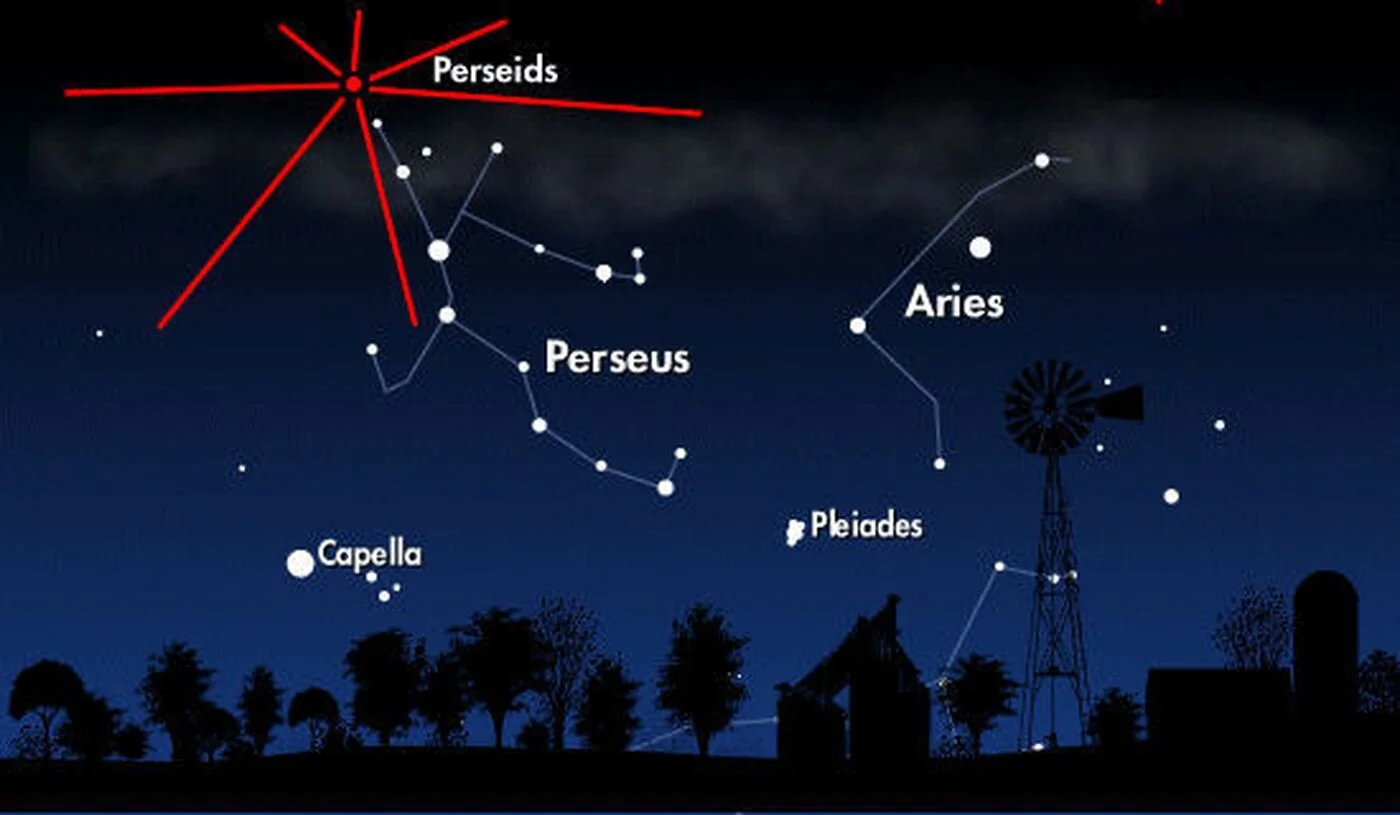10:00 AM | *The annual Perseid meteor shower peaks August 11-13*
Paul Dorian
Perseid meteors appear to radiate from the constellation Perseus in the northeast sky. (Source: WSFA 12 News (Montgomery, Alabama) /NASA)
Overview
The annual Perseid meteor shower is already underway and this year’s peak activity will come in the early morning hours of August 11-13 (Tuesday/Wednesday/Thursday). The peak viewing this year will take place at a time when the moon is just past its last quarter phase (i.e., about 47% full) so it won’t be ideal, but not a deal breaker. The Perseid meteor shower comes every August as the Earth passes through a cloud of dust that comes from Comet Swift-Tuttle as it approaches the sun.
A last quarter moon appears half-lit by sunshine and half-immersed in its own shadow. It rises in the middle of the night, appears at its highest in the sky around dawn, and sets around midday. It will be a nuisance with respect to the viewing of the meteor shower next week, but not a deal breaker.
Details
The Perseid meteor shower has already begun and it will reach a peak August 11-13 with meteor rates potentially reaching 50-75 per hour in rural locations. The moon will be somewhat of a problem this year as it will be just past its last quarter phase or about 47% full, but it rises late and usually can be shielding somewhat from causing viewing problems. The best time for viewing is usually in the pre-dawn hours (i.e., early Tuesday, early Wednesday and early Thursday); however, there certainly can be plenty of sightings during the late evening hours.
The annual Perseid meteor shower occurs when the Earth passes through a stream of dust from the Comet Swift-Tuttle, as shown in this orbit diagram. (Image credit: Sky & Telescope Magazine)
Every year, from around July 17 to August 24, our planet Earth crosses the orbital path of Comet Swift-Tuttle, the parent of the Perseid meteor shower. Debris from this comet litters the comet’s orbit, but we don’t really get into the thick of the comet rubble until after the first week of August. Earth's gravity pulls in chunks of small rocks from Comet Swift-Tuttle comprised of iron-nickel, stone, and other minerals. These small rocks turn into bright balls of hot gas when they enter the Earth's atmosphere. As darkness falls, the meteors appear to come from the constellation Perseus, hence the name; although late in the evening, the meteors actually originate higher in the sky than the constellation.
A photo of Perseid meteors seen in 2019 from Macedonia. Courtesy spaceweather.com/Stojan Stojanovski
It is estimated that Perseid meteoroids hit our atmosphere at about 132,000 miles per hour to produce the annual light show and this meteor shower is usually rich in “fireballs” because of the size of the parent comet. Comet Swift-Tuttle has a huge nucleus - about 26 kilometers in diameter - whereas most other comets are much smaller with nuclei only a few kilometers across. Comet Swift-Tuttle has a very eccentric – oblong – orbit that takes this comet outside the orbit of Pluto when farthest from the sun, and inside the Earth’s orbit when closest to the sun. It orbits the sun in a period of about 133 years. Every time this comet passes through the inner solar system, the sun warms and softens up the ices in the comet, causing it to release fresh comet material into its orbital stream. Typically, meteors are only the size of pebbles, some as small as a grain of sand, but Comet Swift-Tuttle produces a large number of meteoroids that are large enough to produce “fireballs”. In fact, the Perseid meteor shower is considered the “fireball champion” of all of the annual meteor showers.
We’ll be able to see Perseids for ten days or so after the peak mornings on August 11, 12 and 13, though at considerably reduced numbers. Yet, each day as the moon wanes in the morning sky there will be less moonlight to interfere with the show. Starting on or around August 17, moon-free skies reign all night long.
Meteorologist Paul Dorian
Perspecta, Inc.
perspectaweather.com
Follow us on Facebook, Twitter, YouTube




